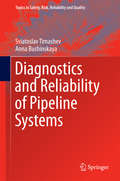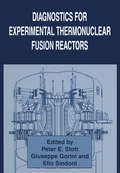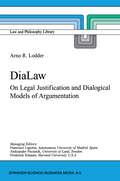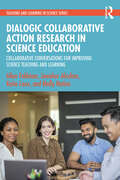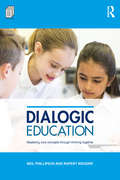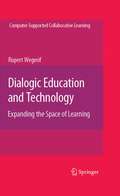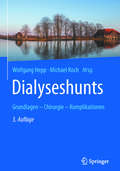- Table View
- List View
Diagnostic Systems For Energy Equipments (Studies in Systems, Decision and Control #281)
by Vitalii P. Babak Serhii V. Babak Mykhailo V. Myslovych Artur O. Zaporozhets Valeriy M. ZvaritchThis book examines key issues in ensuring the operational reliability of energy facilities. In this regard, it analyzes mathematical models of diagnostic signals that arise during the operation of power equipment; reviews the main findings of research into their characteristics; presents diagnostics methods for selected types of electric power and heat engineering equipment; and covers a range of diagnostic and monitoring systems and devices for power equipment. Given its scope, the book offers a valuable resource for researchers, engineers and specialists, as well as instructors and graduate students at institutions of higher learning.
Diagnostic Techniques in Industrial Engineering (Management and Industrial Engineering)
by Mangey Ram J. Paulo DavimThis book presents the most important tools, techniques, strategy and diagnostic methods used in industrial engineering. The current widely accepted methods of diagnosis and their properties are discussed. Also, the possible fruitful areas for further research in the field are identified.
Diagnostic Ultrasound: Imaging and Blood Flow Measurements, Second Edition
by K. Kirk ShungOffers an Extensive Discussion on High Frequency UltrasoundBased on a course taught and developed by a foremost expert in diagnostic ultrasound technology, Diagnostic Ultrasound: Imaging and Blood Flow Measurements, Second Edition covers cutting-edge developments, along with the fundamental physics, instrumentation, system architecture, clinical ap
Diagnostic Ultrasound, Third Edition: Physics and Equipment
by Peter R. Hoskins Kevin Martin Abigail ThrushThis popular text provides a comprehensive, yet accessible, introduction to the physics and technology of medical ultrasound, with high quality ultrasound images and diagrams throughout. Covering all aspects of the field at a level that meetings the requirements of accredited sonography courses, it is ideal for both trainee and qualified healthcare professionals practising ultrasound in a clinical setting. Building on the content of previous editions, this third edition provides the latest guidance relating to ultrasound technology, quality assurance and safety and discusses the latest techniques.
Diagnostic Ultrasound, Third Edition: Physics and Equipment
by Peter R Hoskins, Kevin Martin and Abigail ThrushThis popular text provides a comprehensive, yet accessible, introduction to the physics and technology of medical ultrasound, with high quality ultrasound images and diagrams throughout. Covering all aspects of the field at a level that meetings the requirements of accredited sonography courses, it is ideal for both trainee and qualified healthcare professionals practising ultrasound in a clinical setting. Building on the content of previous editions, this third edition provides the latest guidance relating to ultrasound technology, quality assurance and safety and discusses the latest techniques.
Diagnostics and Reliability of Pipeline Systems (Topics in Safety, Risk, Reliability and Quality #30)
by Sviatoslav Timashev Anna BushinskayaThe book contains solutions to fundamental problems which arise due to the logic of development of specific branches of science, which are related to pipeline safety, but mainly are subordinate to the needs of pipeline transportation. The book deploys important but not yet solved aspects of reliability and safety assurance of pipeline systems, which are vital aspects not only for the oil and gas industry and, in general, fuel and energy industries , but also to virtually all contemporary industries and technologies.The volume will be useful to specialists and experts in the field of diagnostics/ inspection, monitoring, reliability and safety of critical infrastructures. First and foremost, it will be useful to the decision making persons —operators of different types of pipelines, pipeline diagnostics/inspection vendors, and designers of in-line –inspection (ILI) tools, industrial and ecological safety specialists, as well as to researchers and graduate students.
Diagnostics for Experimental Thermonuclear Fusion Reactors
by Giuseppe Gorini Elio Sindoni Peter E. StottThis book of proceedings collects the papers presented at the Workshop on Diagnostics for ITER, held at Villa Monastero, Varenna (Italy), from August 28 to September 1, 1995. The Workshop was organised by the International School of Plasma Physics "Piero Caldirola. " Established in 1971, the ISPP has organised over fifty advanced courses and workshops on topics mainly related to plasma physics. In particular, courses and workshops on plasma diagnostics (previously held in 1975, 1978, 1982, 1986, and 1991) can be considered milestones in the history of this institution. Looking back at the proceedings of the previous meetings in Varenna, one can appreciate the rapid progress in the field of plasma diagnostics over the past 20 years. The 1995 workshop was co-organised by the Istituto di Fisica del Plasma of the National Research Council (CNR). In contrast to previous Varenna meetings on diagnostics, which have covered diagnostics in present-day tokamaks and which have had a substantial tutorial component, the 1995 workshop concentrated specifically on the problems and challenges of ITER diagnostics. ITER (the International Thennonuclear Experimental Reactor, a joint venture of Europe, Japan, Russia, and the United States, presently under design) will need to measure a wide range of plasma parameters in order to reach and sustain high levels of fusion power. A list of the measurement requirements together with the parameter ranges, target measurement resolutions, and accuracies provides the starting point for selecting a list of candidate diagnostic systems.
Diagnostics for Experimental Thermonuclear Fusion Reactors 2
by Peter E. Stott Giuseppe Gorini Paolo PrandoniThis book of proceedings collects the papers presented at the workshop on "Diagnostics for Experimental Fusion Reactors" held at Villa Monastero, Varenna (Italy) September 4-12, 1997. This workshop was the seventh organized by the International School of Plasma Physics "Piero Caldirola" on the topic of plasma diagnostics and the second devoted to the diagnostic studies for the International Thermonuclear Experimental Reactor (ITER). The proceedings of the first workshop on ITER diagnostics were published by Plenum Press in 1996 with the title "Diagnostics for Experimental Thermonuclear Fusion Reactors". While many of the ideas and studies reported in the first workshop remain valid, there has been sub stantial progress in the design and specification of many diagnostics for ITER. This moti vated a second workshop on this topic and the publication of a new book of proceedings. ITER is a joint venture between Europe, Japan, Russia and USA in the field of con trolled thermonuclear fusion research. The present aim of ITER is to design an experimental fusion reactor that can demonstrate ignition and sustained burn in a magnetically confined plasma. To achieve this goal, a wide range of plasma parameters will have to be measured reliably. It is also anticipated that diagnostics will be used much more extensively as input to control systems on ITER than on present fusion devices and this will require increased relia bility and long-term stability.
Diagnostics in Plant Breeding
by Thomas Lübberstedt and Rajeev K. Varshney“Diagnostics in Plant Breeding” is systematically organizing cutting-edge research reviews on the development and application of molecular tools for the prediction of plant performance. Given its significance for mankind and the available research resources, medical sciences are leading the area of molecular diagnostics, where DNA-based risk assessments for various diseases and biomarkers to determine their onset become increasingly available. So far, most research in plant genomics has been directed towards understanding the molecular basis of biological processes or phenotypic traits. From a plant breeding perspective, however, the main interest is in predicting optimal genotypes based on molecular information for more time- and cost-efficient breeding schemes. It is anticipated that progress in plant genomics and in particular sequence technology made recently will shift the focus from “explanatory” to “predictive” in crop science. This book assembles chapters on all areas relevant to development and application of predictive molecular tools in plant breeding by leading authorties in the respective areas.
Diagnostics of Mechatronic Systems (Studies in Systems, Decision and Control #345)
by Pavol Božek Yury Nikitin Tibor KrenickýThis book provides novel approach to the diagnosis of complex technical systems that are widely used in various kinds of transportation, energy, metallurgy, metalworking, fuels, mining, chemical, paper industries, etc.Effective diagnostic systems are necessary for the early detection of errors in mechatronic systems, for the organization of maintenance and for the assessment of the performed service quality. Unfortunately, the practical use of AI in the diagnosis of mechatronic systems is still quite limited and the inability to build effective mechatronic systems leads to significant economic losses and dangers. The main aim of this book is to contribute to knowledge within the topic of diagnostics of mechatronic systems by the analysis of the elements reliability characteristics, using methods, models and algorithms for diagnostics and by studying examples of model diagnostic systems using AI methods based on neural networks, fuzzy inference systems and genetic algorithms.
Diagnostics of Rotating Machines in Power Plants: Proceedings of the CISM/IFToMM Symposium, October 27–29, 1993, Udine, Italy (CISM International Centre for Mechanical Sciences #352)
by G. DianaThe papers presented on this occasion examined the most significant aspects of diagnostic strategies, emphasizing the importance of predictive maintenance in reducing production shortages and the costs of plant management. The contributions of these authors allow a critical comparison of the varied experiences in developing and applying the different diagnostic methodologies employed in several parts of the world. The following problems are discussed: characteristics of condition monitoring systems - data acquisition techniques and data processing methodologies; choice of transducers and of measurement point locations; data compression techniques; alarm levels evaluation (acceptance regions); strategies for detecting malfunction conditions; diagnostic methodologies for the on-line and off-line identification of the cause of fault; expert systems; definition of the guidelines for the presentation in control rooms of monitoring data and diagnostic results; rotordynamic models used, off-line, to confirm faults diagnosed on-line.
Diagrams and Gestures: Mathematics, Philosophy, and Linguistics (Lecture Notes in Morphogenesis)
by Francesco La Mantia Charles Alunni Fernando ZalameaDrawing a line, and then another, and another. Go back from the lines to the movements they capture and see gestures in them: not spatial displacements, but modes of knowledge that pass through the exercise of the body. Discovering something new in a gesture: the line that contracts into a point or the point that expands into a zone, perhaps sinking into a hole. Thus experiencing a diagram: a becoming other inscribed in the novelty of the gesture and in the changes of the forms it shapes. This and much more is discussed in the essays gathered in Diagrams and Gestures. Resulting from trans-disciplinary work between mathematicians, philosophers, linguists and semioticians, the volume delivers an up-to-date account of the most valuable research on the connections between gesture and diagram. As one of the most important themes in contemporary thought, the study of these connections poses a challenge for the future: to elaborate a theory that is equal to new and stimulating research methodologies. We call this theory a philosophy of diagrammatic gestures.
DiaLaw: On Legal Justification and Dialogical Models of Argumentation (Law and Philosophy Library #42)
by A.R. LodderThis book is a revised version of my dissertation 'DiaLaw - on legal th justification and dialog games' that I defended on June 5 1998 at the Universiteit Maastricht. The chapters 1, 4 & 5 (now: 1, 5 & 6) of my dissertation have remained largely unaltered. In chapter 2 I added explicitly the distinction between constructing legal justification and reconstructing it, and tried to elucidate the differences (and similarities) between the product and process of justification. Chapter 3 is divided into two chapters: one on the general characteristics of DiaLaw (now: chapter 3), and the other on specific, legal characteristics of DiaLaw (now: chapter 4). In order to improve readability, all rules in these chapters have been rewritten considerably. The section on the implementation of DiaLaw is moved to the appendix. In chapter 7 (the former chapter 6), a discussion of the notions 'procedural' and 'structural' arguments is added, and different layers in argumentation models are discussed. Finally, in chapter 8 (the former chapter 7) is added a recapitulation of my view on legal justification, and a discussion on the future use in legal practice of dialog models that represent argumentation in a natural way. The main thesis has remained unaltered: legal justification should be modeled as a procedural, dialogical model in which not only products of argumentation are allowed, but, even in formal models, rhetorical, psychological aspects of argument are dealt with.
Dialect Accent Features for Establishing Speaker Identity: A Case Study (SpringerBriefs in Speech Technology)
by Manisha Kulshreshtha Ramkumar MathurDialect Accent Features for Establishing Speaker Identity: A Case Study discusses the subject of forensic voice identification and speaker profiling. Specifically focusing on speaker profiling and using dialects of the Hindi language, widely used in India, the authors have contributed to the body of research on speaker identification by using accent feature as the discriminating factor. This case study contributes to the understanding of the speaker identification process in a situation where unknown speech samples are in different language/dialect than the recording of a suspect. The authors' data establishes that vowel quality, quantity, intonation and tone of a speaker as compared to Khariboli (standard Hindi) could be the potential features for identification of dialect accent.
Dialogic Collaborative Action Research in Science Education: Collaborative Conversations for Improving Science Teaching and Learning (ISSN)
by Allan Feldman Jawaher Alsultan Katie Laux Molly NationThis engaging and practical book offers science teacher educators and K-12 science teachers alike the tools to engage in a dialogic mode of collaborative action research (D-CAR), a collaborative mode of action research focused on teachers’ experiences with students, reflection upon these experiences, and peer learning.Renowned science educator Allan Feldman and co-authors from across numerous settings in K-12 science education present the theory, methodology, case studies, and practical advice to support the use of D-CAR as a means to enhance teachers’ normal practice and address the problems, dilemmas, and dissonances that science teachers must negotiate as they work to meet the needs of an increasingly diverse student population and engage with complex science teaching challenges that disproportionately affect marginalized students.The book will be of use to science teacher educators, pre-service and in-service science teachers, professional development specialists, or any science educator invested in developing creative, reflective, and thoughtful teachers.
Dialogic Collaborative Action Research in Science Education: Collaborative Conversations for Improving Science Teaching and Learning (ISSN)
by Allan Feldman Jawaher Alsultan Katie Laux Molly NationThis engaging and practical book offers science teacher educators and K-12 science teachers alike the tools to engage in a dialogic mode of collaborative action research (D-CAR), a collaborative mode of action research focused on teachers’ experiences with students, reflection upon these experiences, and peer learning.Renowned science educator Allan Feldman and co-authors from across numerous settings in K-12 science education present the theory, methodology, case studies, and practical advice to support the use of D-CAR as a means to enhance teachers’ normal practice and address the problems, dilemmas, and dissonances that science teachers must negotiate as they work to meet the needs of an increasingly diverse student population and engage with complex science teaching challenges that disproportionately affect marginalized students.The book will be of use to science teacher educators, pre-service and in-service science teachers, professional development specialists, or any science educator invested in developing creative, reflective, and thoughtful teachers.
Dialogic Education: Mastering core concepts through thinking together
by Neil Phillipson Rupert WegerifDialogue has long been used in primary classrooms to stimulate thinking, but it is not always easy to unite the creative thinking of good dialogue with the need for children to understand the core concepts behind knowledge-rich subjects. A sound understanding of key concepts is essential to progress through the national curriculum, and assessment of this understanding along with effective feedback is central to good practice. Dialogic Education builds upon decades of practical classroom research to offer a method of teaching that applies the power of dialogue to achieving conceptual mastery. Easy-to-follow template lesson plans and activity ideas are provided, each of which has been tried and tested in classrooms and is known to succeed. Providing a structure for engaging children and creating an environment in which dialogue can flourish, this book is separated into three parts: Establishing a classroom culture of learning; Core concepts across the curriculum; Wider dialogues: Educational adventures in the conversation of mankind. Written to support all those in the field of primary education, this book will be an essential resource for student, trainee and qualified primary teachers interested in the educational importance of dialogue.
Dialogic Education: Mastering core concepts through thinking together (Computer-supported Collaborative Learning Ser. #7)
by Neil Phillipson Rupert WegerifDialogue has long been used in primary classrooms to stimulate thinking, but it is not always easy to unite the creative thinking of good dialogue with the need for children to understand the core concepts behind knowledge-rich subjects. A sound understanding of key concepts is essential to progress through the national curriculum, and assessment of this understanding along with effective feedback is central to good practice. Dialogic Education builds upon decades of practical classroom research to offer a method of teaching that applies the power of dialogue to achieving conceptual mastery. Easy-to-follow template lesson plans and activity ideas are provided, each of which has been tried and tested in classrooms and is known to succeed. Providing a structure for engaging children and creating an environment in which dialogue can flourish, this book is separated into three parts: Establishing a classroom culture of learning; Core concepts across the curriculum; Wider dialogues: Educational adventures in the conversation of mankind. Written to support all those in the field of primary education, this book will be an essential resource for student, trainee and qualified primary teachers interested in the educational importance of dialogue.
Dialogic Education and Technology: Expanding the Space of Learning (Computer-Supported Collaborative Learning Series #7)
by Rupert WegerifThis book empowers people to go beyond themselves into new spheres of learning, thinking and creativity. Drawing on recent work in communications theory as well as psychology, computer science and philosophy, it reveals some key characteristics of learning dialogues. It also demonstrates ways in which computers and networks can deepen, enrich and expand such dialogues. The book’s central argument is that this dialogic perspective in education and the latest developments in information and communications technology make ideal partners.
Dialogmodellierung für multimediale Benutzerschnittstellen (Teubner Texte zur Informatik #14)
by Rainer GötzeDialogorientiertes Umweltmanagement und Umweltqualifizierung: Eine Praxishilfe für mittelständische Unternehmen
by Guido Becke Bärbel Meschkutat Tanja Gangloff Petra WeddigeDie Chancen des betrieblichen Umweltmanagements lassen sich erst in vollem Umfang nutzen, wenn möglichst viele Fach- und Führungskräfte sowie Mitarbeiter dieses und die damit verknüpften Ziele mittragen. Ein umweltorientiertes Ideen- und Veränderungsmanagement erfordert daher, betriebliche Umweltziele und deren Umsetzung in allen Abteilungen und in Anlehnung an die Geschäftsprozesse zu verankern. Der Leitfaden leistet hierzu wesentliche Beiträge: Er zeigt zum einen Verfahren und Maßnahmen zur umweltorientierten Sensibilisierung und Aktivierung von Mitarbeitern auf. Zum anderen wird ein Umweltqualifizierungskonzept mit verschiedenen Bausteinen und Arbeitsmaterialien vorgestellt, das die Handlungskompetenzen von Fach- und Führungskräften sowie engagierten Mitarbeitern im betrieblichen Umweltmanagement fördert. Die Seminareinheiten entsprechen modernen Ansätzen der Erwachsenenbildung und knüpfen an das Know-How und den Erfahrungsschatz von Praktikern an.
Dialogues with Social Robots: Enablements, Analyses, and Evaluation (Lecture Notes in Electrical Engineering #427)
by Kristiina Jokinen Graham WilcockThis book explores novel aspects of social robotics, spoken dialogue systems, human-robot interaction, spoken language understanding, multimodal communication, and system evaluation. It offers a variety of perspectives on and solutions to the most important questions about advanced techniques for social robots and chat systems. Chapters by leading researchers address key research and development topics in the field of spoken dialogue systems, focusing in particular on three special themes: dialogue state tracking, evaluation of human-robot dialogue in social robotics, and socio-cognitive language processing. The book offers a valuable resource for researchers and practitioners in both academia and industry whose work involves advanced interaction technology and who are seeking an up-to-date overview of the key topics. It also provides supplementary educational material for courses on state-of-the-art dialogue system technologies, social robotics, and related research fields.
Dialyseshunts: Grundlagen – Chirurgie - Komplikationen
by Wolfgang Hepp Michael KochDie Anwendung von Dialyseshunts in der Behandlung chronisch nierenkranker Patienten wird auch in der 3. Auflage des etablierten Buches fundiert und umfassend in allen Facetten dargestellt. Vorbereitung und Planung sind eine interdisziplinäre Aufgabe für Nephrologen und Gefäßchirurgen. Detailliert werden Auswahl und Anlage der autologen Gefäßzugänge und arteriovenösen Interponate beschrieben, ebenso die Anwendung zentralvenöser Katheter. Ein großes Kapitel ist der Beherrschung von Komplikationen gewidmet. Shuntpflege und Shuntpunktion sind ebenso berücksichtigt wie die Besonderheiten der Gefäßzugänge bei Kindern.




